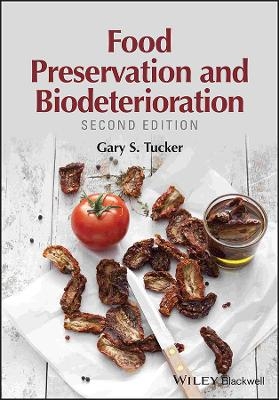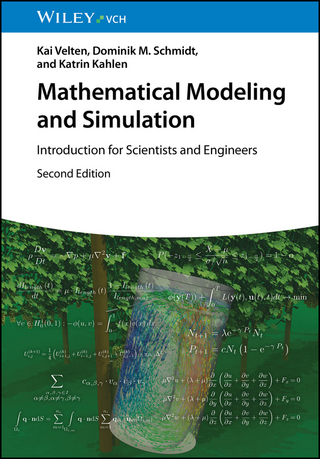
Food Preservation and Biodeterioration
Wiley-Blackwell (Verlag)
978-1-118-90462-6 (ISBN)
- Lieferbar (Termin unbekannt)
- Versandkostenfrei innerhalb Deutschlands
- Auch auf Rechnung
- Verfügbarkeit in der Filiale vor Ort prüfen
- Artikel merken
Biodeterioration is the breakdown of food by agents of microbiological origin, either directly or indirectly from products of their metabolism. Preservation on the other hand is the process by which food materials are maintained in their original condition or as close to this as possible.
This second edition of Food Preservation and Biodeterioration is fully updated and reorganised throughout. It discusses how the agents of food biodeterioration operate and how the commercial methods available to counteract these agents are applied to produce safe and wholesome foods. With this book, readers will discover traditional methods and major advances in preservation technology. Both microbiological and chemical pathways are analysed.
This topic being important to all producers of food, the readership spans food scientists across the industry and academia, particularly those involved with safety and quality.
GARY S. TUCKER is head of the Baking and Cereal Procession Department, Campden BRI Group, UK.
Preface xi
1 Control of Biodeterioration in Food 1
1.1 Overview 1
1.2 A summary of the different kinds of biodeterioration 2
1.2.1 Chemical biodeterioration 2
1.2.2 Physical biodeterioration 2
1.3 Kinds of living organisms involved in biodeterioration 5
1.3.1 Bacteria 5
1.3.2 Fungi 5
1.3.3 Algae, mosses and liverworts 5
1.3.4 Higher plants 5
1.3.5 Insects 5
1.3.6 Birds, mammals and reptiles 6
1.4 Food biodeterioration 6
1.4.1 The composition of food 7
1.5 Description of the mechanisms of food biodeterioration 10
1.5.1 Fermentation 10
1.5.2 Fermentation biochemistry 22
1.5.3 Putrefaction 23
1.5.4 Lypolysis 23
1.6 Microorganisms involved in biodeterioration reactions 24
1.6.1 Factors that affect microbial growth 24
1.6.2 Bacteria 27
1.6.3 Moulds 32
1.6.4 Yeasts 34
References 35
2 Principles of HACCP: The Importance of HACCP Systems in Food Manufacturing 36
2.1 Introduction and historical perspective 36
2.2 The haccp principles and Codex (cac 1997) 37
2.3 HACCP implementation: Important considerations 40
2.3.1 Prerequisite programmes 40
2.3.2 Application of the HACCP principles and the importance of training 41
2.4 The importance of haccp in food manufacturing: The preventative mindset 44
2.4.1 Food design 45
2.4.2 Food manufacturing 46
2.4.3 Globalization and trade 47
2.5 The legal position 47
2.6 Closing thoughts 49
Appendices 49
Appendix 2.A: Example of the make]up of an HACCP team 50
Appendix 2.B: Example of a product description 50
Appendix 2.C: Examples of process flow diagrams 51
Appendix 2.D: Hazard analysis tool as an example guide 53
Appendix 2.E: Examples of hazard analysis and CCP decision logic: Fresh vegetables, rice, vinaigrette, salad blending and assembly 54
Appendix 2.F: Example of the HACCP control chart (for rice salad) 58
References 59
3 Thermal Processing 60
3.1 Introduction 60
3.2 Sterilisation – low]acid foods 61
3.2.1 History of the canning industry 61
3.2.2 F0 3 sterilisation processes 63
3.2.3 Commercial sterilisation 66
3.2.4 Microorganism death kinetics 67
3.2.5 Log reductions 69
3.3 Pasteurisation 71
3.3.1 Control of the microorganism loading 75
3.3.2 Use of restrictive pH levels 75
3.3.3 Low temperatures 77
3.3.4 Dehydration or low water activity 79
3.3.5 Chemical preservation 80
3.4 Equipment for thermal processing 82
3.4.1 Heat exchangers 83
3.4.2 In]pack retorting 84
3.4.3 In]vessel systems 86
3.5 Conclusions 86
References 87
4 Chilling 89
4.1 Introduction 89
4.1.1 Effect of chilling on microorganism growth 90
4.1.2 Effect of chilling on enzymes and biochemical reactions 91
4.1.3 Effect of chilling on physical processes 92
4.1.4 Effect of chilling on physiological processes 93
4.2 Chilling operations 94
4.2.1 Moving air systems 95
4.2.2 Direct contact 100
4.2.3 Jacketed heat exchangers 101
4.2.4 Immersion/spray 104
4.2.5 Ice 105
4.2.6 Vacuum 106
4.2.7 Cryogenic 108
4.3 Chilled storage 111
4.3.1 Controlled atmosphere storage rooms 112
4.4 Retail display 112
4.4.1 Unwrapped products 113
4.4.2 Wrapped products 115
4.5 Conclusions 116
References 117
5 Freezing 119
5.1 Introduction 119
5.2 The physical and chemical aspects of freezing 121
5.3 The effect of freezing on microorganisms 127
5.4 Food freezing operations 130
5.5 Monitoring the quality and safety of frozen foods 134
5.6 New developments 135
5.7 Conclusions 137
References 138
6 Drying 139
6.1 Introduction 139
6.2 Drying processes and drying equipment 141
6.2.1 Vacuum drying 149
6.2.2 Freeze drying 151
6.2.3 Spray drying 153
6.2.4 Sun drying 154
6.2.5 Fluidised bed drying 155
6.2.6 Drum drying 157
6.2.7 Osmotic drying 157
6.3 Bacteria deactivation kinetics during the drying process 158
6.4 Concluding remarks 165
References 165
7 Modified Atmosphere Packaging 167
7.1 Introduction 167
7.2 Background information 167
7.2.1 MAP and related terminologies and technologies 168
7.2.2 Gases used for MAP 169
7.2.3 The benefits and disadvantages of MAP 172
7.2.4 Effects of MAP on microbial spoilage 172
7.3 MAP materials 174
7.3.1 Gas permeability 174
7.3.2 WVTR 176
7.3.3 Mechanical properties 176
7.3.4 Sealing reliability 176
7.3.5 Transparency 176
7.3.6 Type of package 176
7.3.7 Microwaveability 177
7.4 MAP machinery 177
7.4.1 Horizontal form–fill–seal 177
7.4.2 Vertical form–fill–seal 177
7.4.3 Thermoform–fill–seal 178
7.4.4 Preformed tray and lidding film 178
7.4.5 Vacuum chamber 178
7.4.6 Snorkel type 179
7.5 Selected MAP food applications 179
7.5.1 Raw red meat products 180
7.5.2 Raw fish and seafood products 180
7.5.3 Cooked, cured and processed meat products 181
7.5.4 Dairy products 182
7.5.5 Bakery products 183
7.5.6 Dried food products 183
7.6 MAP of fresh produce 184
7.6.1 Factors that affect the shelf life of fresh produce 184
7.6.2 Effects of MAP on fresh produce microbial growth and safety 186
7.7 Conclusions 190
References 190
8 Preservatives 193
8.1 Introduction 193
8.1.1 Labelling and legislation 194
8.2 Types of preservatives 195
8.2.1 Chemical preservatives 195
8.2.2 Natural preservatives 198
8.2.3 Modified atmosphere packaging 201
8.3 Conclusions 203
References 204
9 Hurdle Techniques 206
9.1 Introduction 206
9.2 Hurdle technologies 208
9.2.1 Heat treatment 208
9.2.2 Chilling 209
9.2.3 Acidification or low pH 210
9.2.4 Water activity 212
9.2.5 Modified atmosphere 213
9.2.6 Chemical preservatives 214
9.2.7 Natural antimicrobials 216
9.2.8 Microbial interactions 216
9.3 Predictive modelling 217
9.4 Conclusions 220
References 220
10 Novel Commercial Preservation Methods 223
10.1 Introduction 223
10.2 Ohmic heating 224
10.2.1 Background 224
10.2.2 Industrial applications 225
10.2.3 Equipment 227
10.2.4 Packaging considerations 229
10.2.5 Shelf life and product safety 229
10.3 High Pressure Processing (HPP) 229
10.3.1 Background 229
10.3.2 Industrial applications 230
10.3.3 Equipment 231
10.3.4 Packaging requirements 232
10.3.5 Shelf life and product safety 233
10.4 Microwave and radio]frequency heating 233
10.4.1 Background 233
10.4.2 Industrial applications 236
10.4.3 Packaging requirements 240
10.4.4 Shelf life and product safety 240
10.5 Pulsed electric field processing 241
10.5.1 Background 241
10.5.2 Industrial applications 241
10.5.3 Non]preservation applications 242
10.5.4 Equipment 242
10.5.5 Packaging considerations 244
10.5.6 Shelf life and product safety 244
10.6 Irradiation 247
10.6.1 Background 247
10.6.2 Industrial applications 247
10.6.3 Equipment 248
10.6.4 Shelf life and product safety 250
10.7 Conclusions 252
References 253
Index 257
| Erscheinungsdatum | 31.01.2016 |
|---|---|
| Verlagsort | Hoboken |
| Sprache | englisch |
| Maße | 175 x 252 mm |
| Gewicht | 703 g |
| Themenwelt | Naturwissenschaften ► Chemie |
| Technik ► Lebensmitteltechnologie | |
| Weitere Fachgebiete ► Land- / Forstwirtschaft / Fischerei | |
| ISBN-10 | 1-118-90462-1 / 1118904621 |
| ISBN-13 | 978-1-118-90462-6 / 9781118904626 |
| Zustand | Neuware |
| Informationen gemäß Produktsicherheitsverordnung (GPSR) | |
| Haben Sie eine Frage zum Produkt? |
aus dem Bereich


